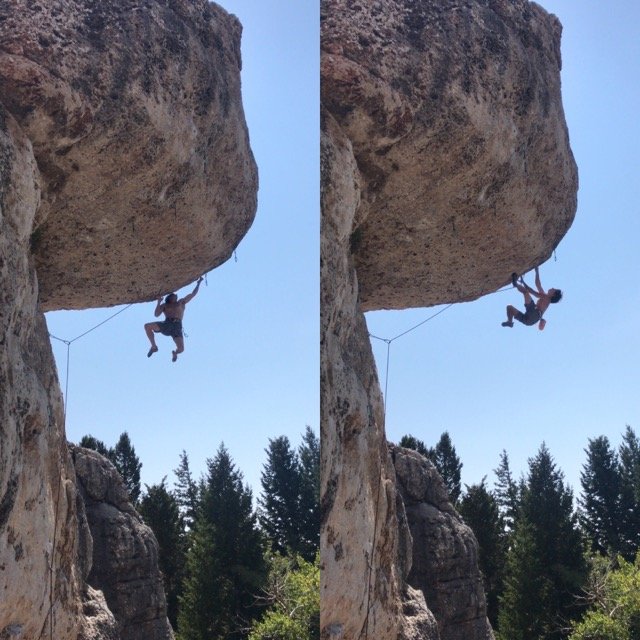When to Walk Away | Strategic Quitting
For many climbers, the lead-up to performance seasons have a consistent trend. You plan out all of the climbs you want to do. You might tell yourself that this is the year to pick out a B.H.A.G. “Big Hairy Audacious Goal”, or possibly a S.M.A.R.T. goal, or maybe some other goal with an equally ridiculous name.
But I’m not here to tell you how to set a goal. I’m here to tell you how to abandon it.
Let’s talk “quitting strategy”. A mistake most people make when choosing projects for the season is that they don’t create one. They will spend countless hours dreaming up how best to prepare for a climb, but they never consider what the circumstances should be for them to walk away from it.
I’ll give you an example from my own experience.
A few years ago I was planning a 12 day trip to Lander to try to send Rodeo Free Europe, a bouldery, pocket-intensive 14a. I had just heard about the “quitting strategy” from author Seth Godin, and decided to give it a try. I wrote out daily checkpoints that I wanted to hit throughout my trip. The route is short and very powerful and I have a history of giving up quickly on that style of route. I hoped that this “quitting strategy” would help me find patience with this aggressive little route rather than fall back to my usual ways and decide to abandon it too early.
With all of my checkpoints written down and training complete I left for Lander confident and psyched to try hard. Two days into my trip it snowed. Wild Iris became temporarily inaccessible. I had hoped to get eight climbing days on the route, and I just lost two of them. I was SO determined not to walk away from this route without giving myself a real chance at it, and losing 25% of my projecting time to weather felt like an easy out.
Thankfully, I had my checkpoints written down, and it was easy to defer to them. One of my checkpoints was to be able to do the route in two overlapping sections with two days left to go. My third to last day came and went and I wasn’t able to get that done.
As bummed as I was about not making my checkpoint, the quitting strategy worked for what I wanted in two seemingly contradictory ways. I stuck with trying this route longer than I normally would have when things went wrong, and when I did decide to walk away for this trip it was not a rushed decision made under stress. The plan helped me to both see things through and to know when to quit.
I ended up spending my last two days of the trip having fun on easier climbs and having zero doubts as to whether or not I made the right decision. I was sad that I didn’t get the time I wanted on the route, but having this plan ahead of time let me feel like I tried my best. I know how long a route like that should take me, and the normal steps it requires. As much as I would have loved for everything to line up perfectly, it didn’t, and using this strategy helped me to go through the process without freaking out about what I should do.
——
As a coach, one of my jobs is to help clients who are in a performance period determine whether they are on the right path, or if it’s time to change their strategy. When someone is on a trip and stressed out about only having three days left and they aren’t sure whether they should stick to the plan or change things up, I can help them walk through the options and make a good choice. Having an outside perspective in these moments can help you to make a decision that isn’t clouded by your emotions.
Creating a quitting strategy lets you be your future-self’s coach for these types of situations. By planning out your terms for when you allow yourself the option to quit ahead of time, you remove a lot of stress out of your trip or climbing season.
Just like how you shouldn’t grocery shop while you are hungry, you shouldn’t decide whether or not to abandon your goal while you are in the most stressful part of trying to achieve it.
Whenever I first tell people about this idea their responses are often the same, “Why would I plan on quitting?”, or “I don’t think like that. I’m just going to keep trying this until I either do it or the season is over.” Quitting has such a negative connotation that we rarely take the time to consider how to use it strategically.
There are plenty of times when quitting turns out to be the right answer. If a climb is too hard for you right now, you might gain more by doing other things first before returning to it. If a boulder starts to hurt your finger or shoulder, you should consider walking away before it creates a real injury that you then have to spend time recovering from. Quitting is a tool, and you should learn how to use it like one.
Let me give you a few scenarios:
You only have a few more weekends of good weather left in the Spring before it’s going to get too hot for your project. You had been making steady progress on this route, but the last two weekends you’ve been falling at the same spot. You haven’t sent anything yet this season and you don’t want to end the season empty handed. Do you keep trying or do you pull back and send easier routes that you know you can do quickly?
You’re on a climbing trip with the plan of trying a single hard boulder. You’re going to have 5 total days to try it. By the end of the second day you still haven’t done all of the moves individually yet. Do you keep trying it or do you scrap the plan and get some “safety sends” to pacify your ticklist...and your ego.
You’ve been trying a boulder for 5 sessions now. Each session has gone a little better, and you know you could do it if you keep trying it. It’s exhausting mentally and physically to try and you’re feeling like you would rather go climb on other things for a while. Maybe you’ll be stronger in the fall and it will be easier then. Do you keep trying or do you put it off until later?
I’m not implying that there is a right answer to the scenarios above. But there is a right answer for you and your situation, and you’re more likely to make the right decision for you if you consider your priorities ahead of time. You need to decide when you are going to quit before you are in the thick of it.
If you want to apply a quitting strategy, but don’t have any big trips planned, here are two simple exercises to challenge yourself with, one for ropes and one for boulderers.
Route Climbers
When you are trying out routes in search of a new project, go up the route twice before you make any sort of judgement about whether it is too hard or not. After you go to the anchors twice you have permission to quit the route if you want.
When people go out and try routes to see if they are worth investing in as a project they often put FAR too much weight on how the route feels on their first go. They quit before they’ve given themselves a chance.
I can’t count the number of times a route has felt incredibly hard on the first try, but by the time I lower off from my second go I’m convinced that it will only take another few more tries to send.
Boulderers
If you listen to the podcast then you’ve heard me describe the ‘7-Go Rule’. If you find a move that’s hard for you, give it seven “goes” before you judge whether it’s too hard. If you make any progress in those seven attempts--even if it seems minor, like some upward movement, or hanging onto a hold a little bit longer--then keep trying (or consider coming back to it soon). If, after seven honest attempts, you made zero progress then maybe it’s too hard for now and you can give yourself permission to quit.
Give these a try and see how they work. If these work well for you, consider planning out a quitting strategy for your next trip or season. You might surprise yourself with how much stress it takes away.
Climbing trips and seasons don’t always go the way we hope. Plan for this ahead of time. We can’t guarantee that we’ll achieve our goals, but if we can improve our decisions a little bit each trip and each season then we’ll start walking away with more and more sends.





































Inspiration is intoxicating, but often fades as quickly as it shows up.